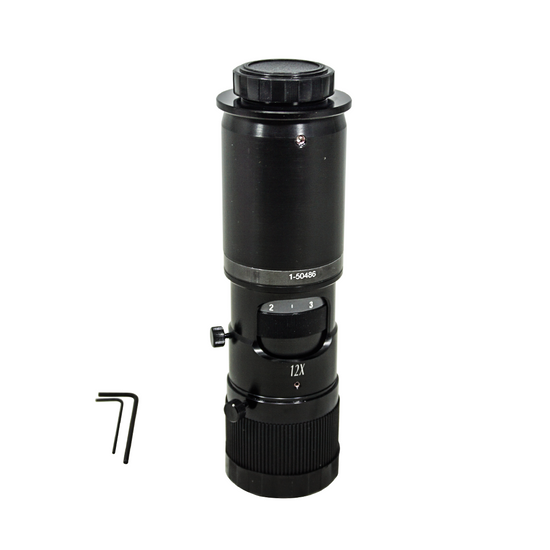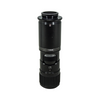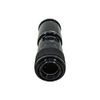Quick Overview
Infinite. Body Magnification: 0.58-7X. Zoom Range: 0.58-7X. Zoom Ratio: 1:12. Body Mounting Size for Stand: Dia. 45.3mm. Built-in Objective Magnification: 1X. Achromatic Objective. Objective Working Distance: 86mm.
Navitar-1-50486 Navitar 12X Zoom, 12 mm Fine Focus
Zoom Lens Body
| Body Optical System | Infinite |
| Body Magnification | 0.58-7X |
| Zoom Range | 0.58-7X |
| Zoom Ratio | 1:12 |
| Zoom Operating Mode | With the Nosepiece |
| Body Mounting Size for Stand | Dia. 45.3mm |
| Body Mount Type for Coupler | Fastening Screw |
| Body Mount Size for Coupler | Dia. 33.3mm |
| Built-in Objective Magnification | 1X |
| Objective Type | Achromatic Objective |
| Objective Working Distance | 86mm |
| Objective Screw Thread | 1.093-32T |
| Surface Treatment | Electroplating Black |
| Material | Metal |
| Color | Black |
| Net Weight | 0.49kg (1.08lbs) |
Technical Info
Instructions
Scope Body PartsClose Λ
| Nosepiece, also known as revolving nosepiece, can be mounted with several objective, and one of which in turn can be switched to the microscope optical axis for use. Nosepiece has different configurations, namely, single, triple, quadruple, and quintuple. Each objective has a ball buckle at its position to ensure that the objective is in the exact fixed position of the optical axis. Since any one set of objectives has the same parfocal distance, so when the objective is switched between high and low magnifications for observation, it is almost unnecessary to perform again the focusing operation. Nosepiece can be divided into two types, namely, inward nosepiece and outward nosepiece, depending on the positional direction. After switching, the tube of inward nosepiece is inclined to the side of the microscope body, which can save people's operating space and prevents it from hitting the lens. In general, after the objective is mounted onto the nosepiece, no special coaxial processing is required. If necessary, remove the nosepiece, and adjust the position of the end point screw on the dovetail rail behind the nosepiece. If the objective is still off-axis, adjust the optical axis of the condenser to match the optical axis center of the objective. In the use of microscope, if one set of objective cannot be parfocal, there are many reasons for the problem, but it may be that the nosepiece or the set of objective itself cannot guarantee parfocalness due to problems of processing precision. In this case, after confirming that the high and low magnifications of the objectives at both ends are in focus, adjust the objective of the middle magnification, and usually try to add a thin "shims" to correct. For normal switching of the objective, it is necessary to push the nosepiece instead of pushing and pulling the objective to prevent the objective and the nosepiece from deviating from the optical axis or loosening, so as to avoid image out of focus or damage. |
InfiniteClose Λ
| Microscopes and components have two types of optical path design structures. One type is finite optical structural design, in which light passing through the objective lens is directed at the intermediate image plane (located in the front focal plane of the eyepiece) and converges at that point. The finite structure is an integrated design, with a compact structure, and it is a kind of economical microscope. Another type is infinite optical structural design, in which the light between the tube lens after passing the objective lens becomes "parallel light". Within this distance, various kinds of optical components necessary such as beam splitters or optical filters call be added, and at the same time, this kind of design has better imaging results. As the design is modular, it is also called modular microscope. The modular structure facilitates the addition of different imaging and lighting accessories in the middle of the system as required. The main components of infinite and finite, especially objective lens, are usually not interchangeable for use, and even if they can be imaged, the image quality will also have some defects. The separative two-objective lens structure of the dual-light path of stereo microscope (SZ/FS microscope) is also known as Greenough. Parallel optical microscope uses a parallel structure (PZ microscope), which is different from the separative two-object lens structure, and because its objective lens is one and the same, it is therefore also known as the CMO common main objective. |
Zoom RangeClose Λ
| Zoom in zoom microscope means to obtain different magnifications by changing the focal length of the objective lens within a certain range through adjustment of some lens or lens set while not changing the position of the object plane (that is, the plane of the point of the observed object perpendicular to the optical axis) and the image plane (that is, the plane of the image imaging focus and perpendicular to the optical axis) of the microscope. Zoom range refers to the range in which the magnification is from low to high. In the zoom range of the microscope, there is no need to adjust the microscope knob for focusing, and ensure that the image is always clear during the entire zoom process. The larger the zoom range, the stronger the adaptability of the range for microscope observation, but the image effects at both ends of the low and high magnification should be taken into consideration, the larger the zoom range, the more difficult to design and manufacture, and the higher the cost will be. |
Zoom RatioClose Λ
| Zoom ratio is the ratio of the maximum magnification / the minimum magnification. Expressed as 1: (ratio of maximum magnification / minimum magnification). If the maximum magnification is 4.5X, the minimum magnification is 0.7X, then the zoom ratio = 4.5 / 0.7 = 6.4, the zoom ratio will be 1:6.4. Zoom ratio is obtained by the intermediate magnification group of the microscope. When the magnification is increased or decreased by using other objective lenses, the zoom ratio does not change accordingly. |
With the NosepieceClose Λ
| When the microscope body changes the magnification, it is realized by adjusting the zoom drum or nosepiece. Generally, the lower case of the microscope is used as the zoom drum or nosepiece. When magnification conversion is required, it can be realized by turning the zoom drum or nosepiece. |
Built-in Objective MagnificationClose Λ
| The objective of a stereo microscope is mostly built-in objective, which is usually mounted in the microscope body, and it is one or a set of lenses closest to the object to be observed. When not marked, the built-in objective is 1X. |
Objective TypeClose Λ
| In the case of polychromatic light imaging, the aberration caused by the light of different wavelengths becomes chromatic aberration. Achromatic aberration is to correct the axial chromatic aberration to the two line spectra (C line, F line); apochromatic aberration is to correct the three line spectra (C line, D line, F line). The objective is designed according to the achromaticity and the flatness of the field of view. It can be divided into the following categories. Achromatic objective: achromatic objective has corrected the chromatic aberration, spherical aberration, and comatic aberration. The chromatic portion of the achromatic objective has corrected only red and green, so when using achromatic objective, yellow-green filters are often used to reduce aberrations. The aberration of the achromatic objective in the center of the field of view is basically corrected, and as its structure is simple, the cost is low, it is commonly used in a microscope. Semi-plan achromatic objective: in addition to meeting the requirements of achromatic objective, the curvature of field and astigmatism of the objective should also be properly corrected. Plan achromatic objective: in addition to meeting the requirements of achromatic objectives, the curvature of field and astigmatism of the objective should also be well corrected. The plan objective provides a very good correction of the image plane curvature in the field of view of the objective, making the entire field of view smooth and easy to observe, especially in measurement it has achieved a more accurate effect. Plan semi-apochromatic objective: in addition to meeting the requirements of plan achromatic objective, it is necessary to well correct the secondary spectrum of the objective (the axial chromatic aberration of the C line and the F line). Plan apochromatic objective: in addition to meeting the requirements of plan achromatic objective, it is necessary to very well correct the tertiary spectrum of the objective (the axial chromatic aberration of the C line, the D line and the F line) and spherochromatic aberration. The apochromatic aberration has corrected the chromatic aberration in the range of red, green and purple (basically the entire visible light), and there is basically no limitation on the imaging effect of the light source. Generally, the apochromatic aberration is used in a high magnification objective. |
Objective Working DistanceClose Λ
| The objective working distance is the vertical distance from the foremost surface end of the objective of the microscope to the object surface to be observed. Generally, the greater the magnification, the higher the resolution of the objective, and the smaller the working distance, the smaller the field of view. Conversely, the smaller the magnification, the lower the resolution of the objective, and the greater the working distance, and greater the field of view. High-magnification objectives (such as 80X and 100X objectives) have a very short working distance. Be very careful when focusing for observation. Generally, it is after the objective is in position, the axial limit protection is locked, then the objective is moved away from the direction of the observed object. The relatively greater working distance leaves a relatively large space between the objective and the object to be observed. It is suitable for under microscope operation, and it is also easier to use more illumination methods. The defect is that it may reduce the numerical aperture of the objective, thereby reducing the resolution. |
Objective Screw ThreadClose Λ
| For microscopes of different manufacturers and different models, the thread size of their objectives may also be different. In general, the objective threads are available in two standard sizes, allowing similar objectives between different manufacturers to be used interchangeably. One is the British system: RMS type objective thread: 4/5in X 1/36in, One is metric: M25 X 0.75mm thread. |
PackagingClose Λ
| After unpacking, carefully inspect the various random accessories and parts in the package to avoid omissions. In order to save space and ensure safety of components, some components will be placed outside the inner packaging box, so be careful of their inspection. For special packaging, it is generally after opening the box, all packaging boxes, protective foam, plastic bags should be kept for a period of time. If there is a problem during the return period, you can return or exchange the original. After the return period (usually 10-30 days, according to the manufacturer’s Instruction of Terms of Service), these packaging boxes may be disposed of if there is no problem. |
| Packing | |
| Packaging Type | Carton Packaging |
| Packaging Material | Corrugated Carton |
| Packaging Dimensions(1) | 29x19.5x14.5cm (11.417x7.677x5.709″) |
| Inner Packing Material | Plastic Bag |
| Ancillary Packaging Materials | Expanded Polystyrene |
| Gross Weight | 0.90kg (1.98lbs) |
| Minimum Packaging Quantity | 1pc |
| Transportation Carton | Carton Packaging |
| Transportation Carton Material | Corrugated Carton |
| Transportation Carton Dimensions(1) | 29x19.5x14.5cm (11.417x7.677x5.709″) |
| Total Gross Weight of Transportation(kilogram) | 0.90 |
| Total Gross Weight of Transportation(pound) | 1.98 |
| Quantity of One Transportation Carton | 1pc |















